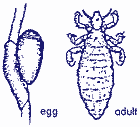|
What are Headlice ?
Headlice
live, eat and breed on the hair and skin of the human scalp. They are small, wingless insects about 2 to 3 cm in length. Headlice
can jump, fly or swim but get about the scalp by moving from hair with strong claws. healthy headlice can be very dificult
to see on the scalp.
Female lice lay about seven to 10 eggs every night. The eggs are
laid close to their food supply - scalp. the eggs which are small whitish flecks, are often seen behind the ears and on the
forehead. They are attached firmly to the hair and are very hard to remove. Eggs hatch about nine days after being laid.
How are headlice spread ?
Because they cannot fly or jump,
headlice must come in close contact with another persons hair to spread. This can be done by sitting, lying next to a person
with headlice or using the same hairbrush, comb or hat. Headlice are not associated with lack of cleanliness.
What are the symptoms and how is it diagnosed ?
Headlice may cause the scalp to itch,
although often there are no symptoms. It is diagnosed either by finding a live insect on the scalp or finding an egg within
1 cm of the scalp (eggs more than 1 cm from the scalp are dead) You do not need to visit your doctor.
How do I reduce the spread of headlice ?
Brushing the hair
often is a cheap and effective way of reducing the spread of lice. This may help kill or injure headlice and stop them laying
eggs. If headlice are a continuing problem in children, encourage them to use their own hook at school to hang their clothes
and belongings. Hats should be hung on hooks and not be put in a communial place. Discourage girls from sharing their ribbons,
clips and ties. Dont worry about washing the bedding and clothes, eggs will not survive away from their food source after
hatching. If everyone uses the combs or brushes in the house, wash them in the shampoo as well. Check for headlice on the
scalps of family members and close friends. Notify your school or pre school.
|
 |
|

Headlice Photos

|
 |
 |
 |
|
Liceaway Advert
How do I treat headlice ?
Insectacide shampoos or
sprays .. Speak to a pharmacist or healthcare provider for advice about what treatment to use. It is very important to follow
the directions on the package carefully, using a clock to time how long the shampoo should be left on. Read the application
instructions carefully before you buy, some will be tolerated better than others by your child.
Remove by hand .. Although slow, this method can be very effective.
Using a nit comb carefully comb through the hair, removing the lice eggs. There is also a comb available that kills lice electronically.
These combs operate on a single battery and zap lice when caught between the fine teeth of the comb. Combing should be done
twice daily for 14 days.Combing tends to work well on children with short, fine hair, and not so good for those children with
curly or long hair.
|
|
 |
 |
 |
|
|
|

